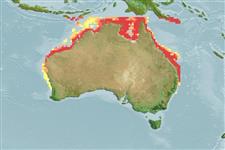Common names from other countries
Environment: milieu / climate zone / depth range / distribution range
Ecologie
; diepteverspreiding 8 - 61 m (Ref. 105423). Subtropical; 10°S - 33°S, 112°E - 154°E
Indo-Pacific: Endemic to Australia.
Length at first maturity / Size / Gewicht / Leeftijd
Maturity: Lm 2.2 range ? - ? cm Max length : 14.5 cm TL mannelijk/geslacht niet bekend; (Ref. 8); 15.5 cm TL (female)
Found on seagrass and offshore habitats (Ref. 104903). Postlarvae settle exclusively in seagrass beds (Ref. 84594). Juveniles live almost exclusively in shallow seagrass beds (Ref. 105190). They feed on bivalves, gastropods, ophiuroids, crustaceans and polychaetes (Ref. 104903), diatoms, filamentous algae, and seagrass (Ref. 105190).
Life cycle and mating behavior
Geslachtsrijpheid | Voortplanting | Kuitschieten | Eieren | Fecundity | Larven
Members of the order Decapoda are mostly gonochoric. Mating behavior: Precopulatory courtship ritual is common (through olfactory and tactile cues); usually indirect sperm transfer.
Holthuis, L.B. 1980. (Ref. 8)
Status op de Rode Lijst van het IUCN (Ref. 130435)
Status bij CITES (Ref. 108899)
Not Evaluated
Not Evaluated
Gebruik door de mens
Visserij: commercieel
FAO - Aquacultuur: production; | FishSource | Sea Around Us
Tools
Internet-bronnen
Estimates based on models
Preferred temperature
(Ref.
115969): 24.6 - 28.2, mean 26.7 (based on 184 cells).
Weerstandsvermogen
Hoog, minimale populatieverdubbelingstijd minder dan 15 maanden (K=2.16-4.21).
Kwetsbaarheid
Low vulnerability (10 of 100).
